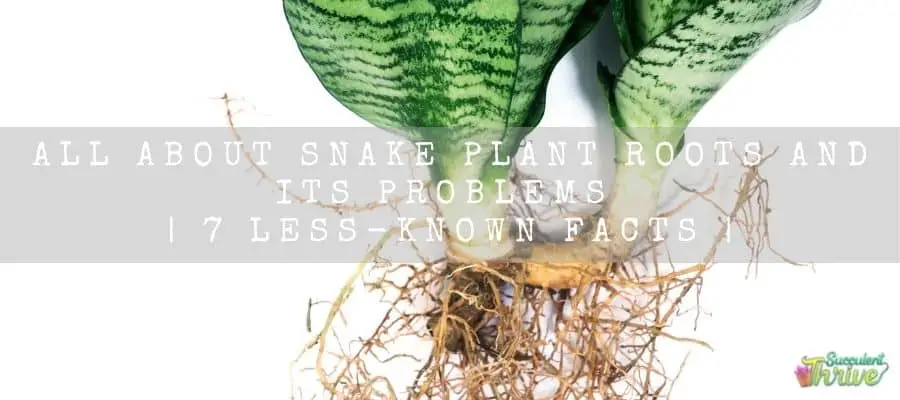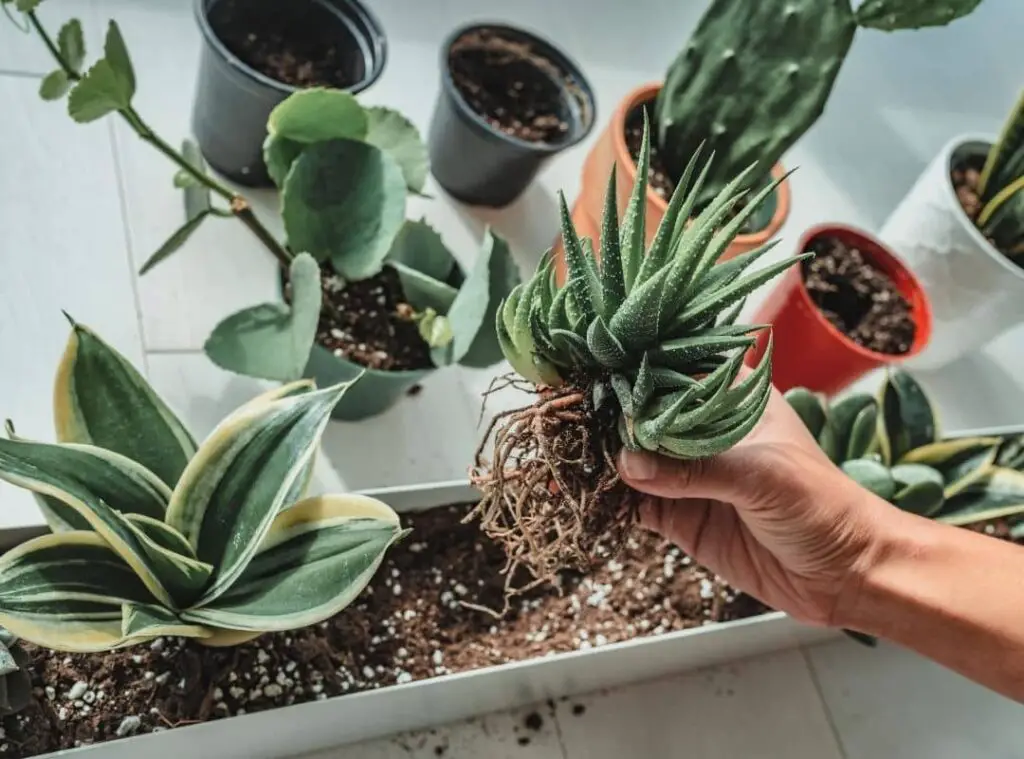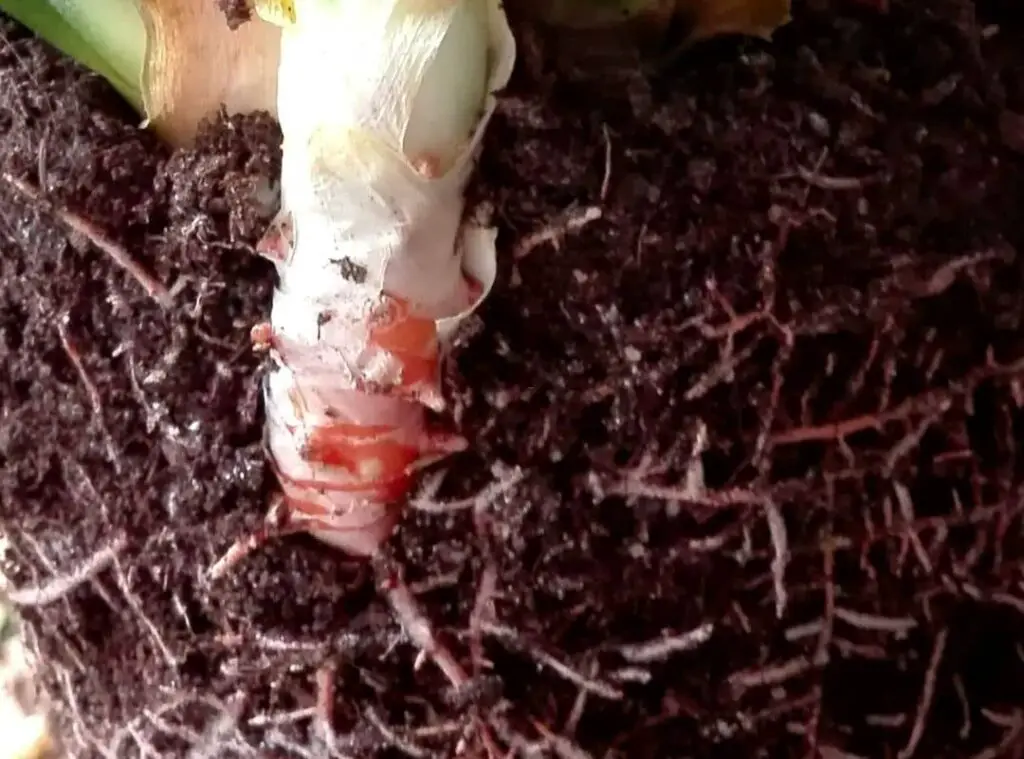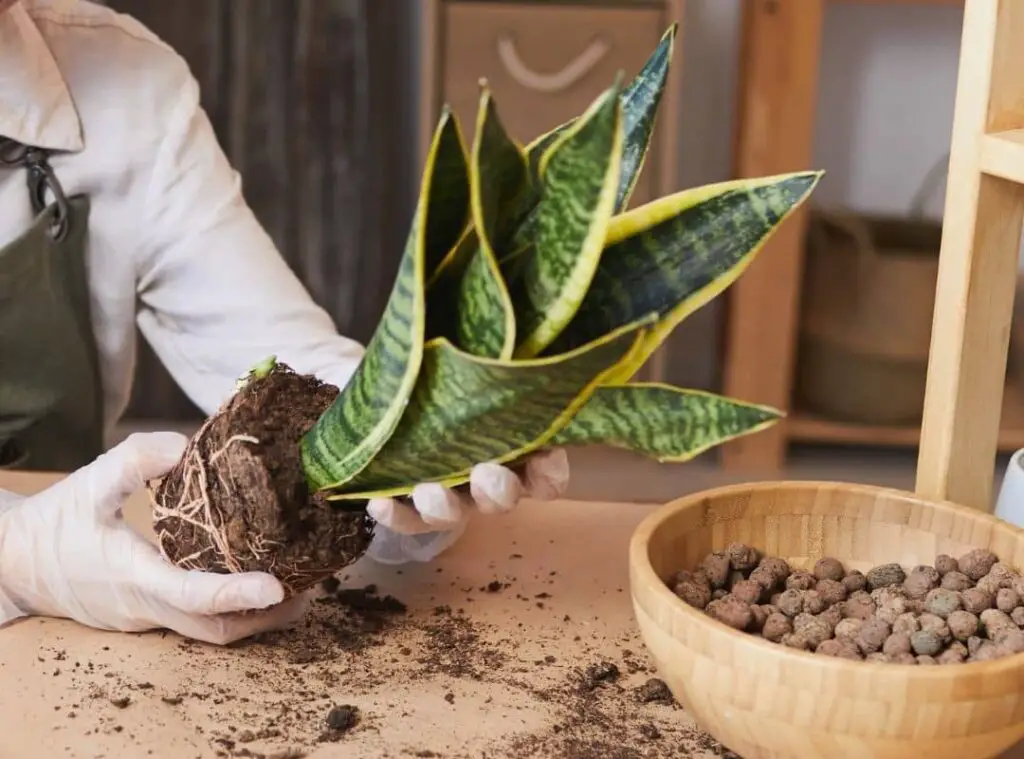When your snake plant roots are healthy it will help the plant to thrive well. It has to be strong and firm too. Furthermore, you could spot healthy root systems in natural white and tan colors too.

Snake plant roots problems
Snake plant roots rot is a major concern when it comes to snake plants root problems.
Issues related to the watering process, particularly over watering during colder months, contribute for root rots to take place.
Chances are that the snake plant roots could perish as they would be running out of oxygen or due to a spread of soil fungus.
Soggy and damp condition of soil would be very attractive towards fungus such as Pythium, phytophthora, Rhizoctonia or Fusarium.
Those conditions would suit them best for their growth and for their multiplication purposes as well.
Once these creatures are present in a snake plant, they could expand up to the roots and start infecting the plants.
Once this takes place, healthy roots could change their usual colors to brown and mushy as they are dying. They will no longer be able to absorb the essential nutrients for their growth.
Snake plant without root
There could be some snake plants which do not have any roots due to several factors.
That could occur as a repercussion of over watering and due to a fungus attack too. Once any fungus invades your snake plant, it could deteriorate the root system of the plant underneath the soil.
However, you have the option of propagating them while doing the following steps.
- You could cut off all the edges wherever any damage has occurred.
- Try applying an antifungal element such as cinnamon on the leaves
- Arrange a potting mix for which you could add peat moss and perlite.
- Place whatever the remaining snake plant leaves in the pot upright.
- Continue with your regular maintenance with the plant and you will be rewarded with a successful outcome.

Snake plant Roots rot
Snake plant roots rot could take place as a repercussion of bacteria and as a fungus attack.
Once the snake plant’s roots are rotten, you may spot them brown. Further they would be soft as well. These pests are fond of soggy and damp conditions of the soil.
These pests could be so bad as they could make so many repercussions for the plant.
You could spot healthy roots of a snake plant in tan which is covered in the soil. When your snake plant consists of a healthy root system, it will help the plant to thrive well.
It has to be a strong root system and firm too. Furthermore, you could spot healthy root systems in natural white in tan colors too.
Over watering is another key factor which will cause the snake plant’s root rots.
Once you supply an excess amount of water for the plants, it will create a soggy and damp condition in the soil and consequently it would attract the above unhealthy fungus and bacteria.
Once a root rot has happened in your plant, it could smell bad too. That is due to the deteriorating root system of the plant.
One more concern when it comes to root rot is that you cannot really come to any assumption without observing the roots of the plant properly as the roots are underneath the soil.
Having said that if you notice any discolored leaves or in the foliage it would be mainly due to root rot.
Propagate snake plant from roots
First, you should choose a healthy snake plant. Then then search for a branched corner of the plant or a small plantlet emerged from the big plant.
Carefully remove the chosen part without harming the big plant. After that, go ahead and place the plant in the potting soil which you had arranged. You could do a light watering on them.
Always keep in mind that you do not over water them purely there is a high potential for the cuttings to root. if you leave them in soggy conditions.
You could conduct a regular check up on the plant once a week or once every couple of weeks to observe whether the top surface of the soil has dried up.
After some time they will start to root and produce pups. They will consume more time than you propagate them cuttings in water.
Alternatively, you could plant multiple cuttings in one pot which could reward you with different varieties of snake plants.
Having said that, it could be somewhat difficult for the cuttings to grow precisely in case they have variegated stripes or margins.

How long should snake plant roots be before planting
You need to wait until the roots become minimum two inches in length before you plant them in a new potting mix.
How to keep snake plant roots healthy
Watering
Just as with other succulents, watering the snake plants is a crucial factor to maintain it’s healthy roots. Snake plants do not depend on a lot of watering.
The main principle in terms of watering the snake plants is that you need to ensure that the soil is dry enough before you water them.
Snake plants can generally thrive well without water for about 6 weeks. If your snake plant is in shade and when there is a low level of temperature available, you need to water them less often.
When you water them, ensure that you do it thoroughly and sparingly.
During spring and in summer, it could be ideally, once every two weeks during summer season. During winter it could be once every month.
During winter, refrain from providing extra water as it could affect the leaves of the plant. If you leave your soil to be in soggy and damp condition it could contribute to root rot.
Fertilizer
It is important that you fertilize the snake plants as appropriate in order to keep the snake plants roots healthy.
Once you utilize excess fertilizers on the snake plants, chances are that it could strain as they are trying to absorb water.
Fertilizers would make the snake plant’s roots expand and look for additional nutrients.
Having said that, excess fertilizers will cause the snake plant roots to become shriveled and perish at the end.
Snake plants in general have adapted to grow in poor rocky soil. As such you need to avoid over fertilizing them.
In terms of fertilizing the snake plants, you could also use a fertilizer which is designed for succulents and for cactus.
If you wish to go for a fertilizer which is designed specifically for snake plants, you should go for a 10-10-10 or 20-20-20 strength fertilizer.
During spring you could feed them once and feed them once again in summer. If your plant is in healthy condition, feeding them once a year would be sufficient.
If it is essential, you could feed them once a month in both spring and in summer. Do not apply any fertilizers for snake plants in winter as it their resting period
Pot and soil
Selecting a proper size pot and a right soil mix matters to keep the snake plant roots healthy.
Consider that you have chosen a larger pot to grow snake plants, then it could create a negative impact on the plants.
It would in fact be attributed to root rot. You should not proceed with unnecessarily big pots when growing snake plants.
Instead, you should go ahead with pots which are slightly larger than your plant. It could be 1-2 inches larger maximum.
In other words, if you grow snake plants in large pots, it will retain excess water in the pot and will make the plant sit in moist conditions for too long which would contribute to root rot.
It will not be possible for the snake plant roots to approach every nook and corner in the pot and consequently excess water will retain in the pot.
Eventually, you will end up having root rots in the plant. That is why you need to select an appropriately sized pot to grow snake plants.
It is vital that you provide a well-draining soil mix for the snake plants to thrive well. Once you use a well-draining soil mix, it allows the water to move through soil rapidly than when you use the regular soil mix. It does not keep the plant in soggy conditions.
Refrain in using clay-based soil as it could retain water for a prolonged time and attribute it to soggy conditions in the soil.
Instead, you should use a sandy soil which is fast draining, and which does not retain excess water. In addition to this you may add elements such as perlite, pumice to enhance the draining of the soil.
Repotting
I would recommend you transplant your snake plant into a new pot along with fresh soil. It will always be refreshing to have a fresh start and new growing conditions.
If you keep the plant in the same old soil for too long and if there were any fungus which were developing, you could get rid of them.
When you transplant, you may trim off the older and damaged leaves which will help you to assess the plant’s health and as well as the condition of the plant’s root system as well.
In this circumstance you could see it properly if root rot has occurred on your plant and if so, you may trim those parts as well.
Snake plant roots coming out of pot
Once you see your snake plant roots have formed out of your pot, it is the time that you need to repot the plant.

Related questions
Do snake plants have deep roots?
Snake plants do not contain deeper roots. They comprise shallow rhizomes for roots.
They could usually grow deeper as 24 inches in larger pots along with heavy soil. Having said that, the snake plant’s roots could grow only half of that depth or even less than that.
Can snake plants grow without roots?
You could use them to regrow snake plants from them.
They could grow without roots mainly due to overwatering related issues or due to fungal attacks.
However, you could use them for propagation and make new plants.
Can you cut snake plant roots?
You could proceed with a regular trimming of the snake plant roots.
Snake plant roots are quite significant in size compared to the size of the plant. If you wish to keep the plant in the same size and if you do not wish to do repotting of the plant, you may prune the snake plant roots.
Read Next: 10 Important Facts You Need To Know About Snake Plant leaves
